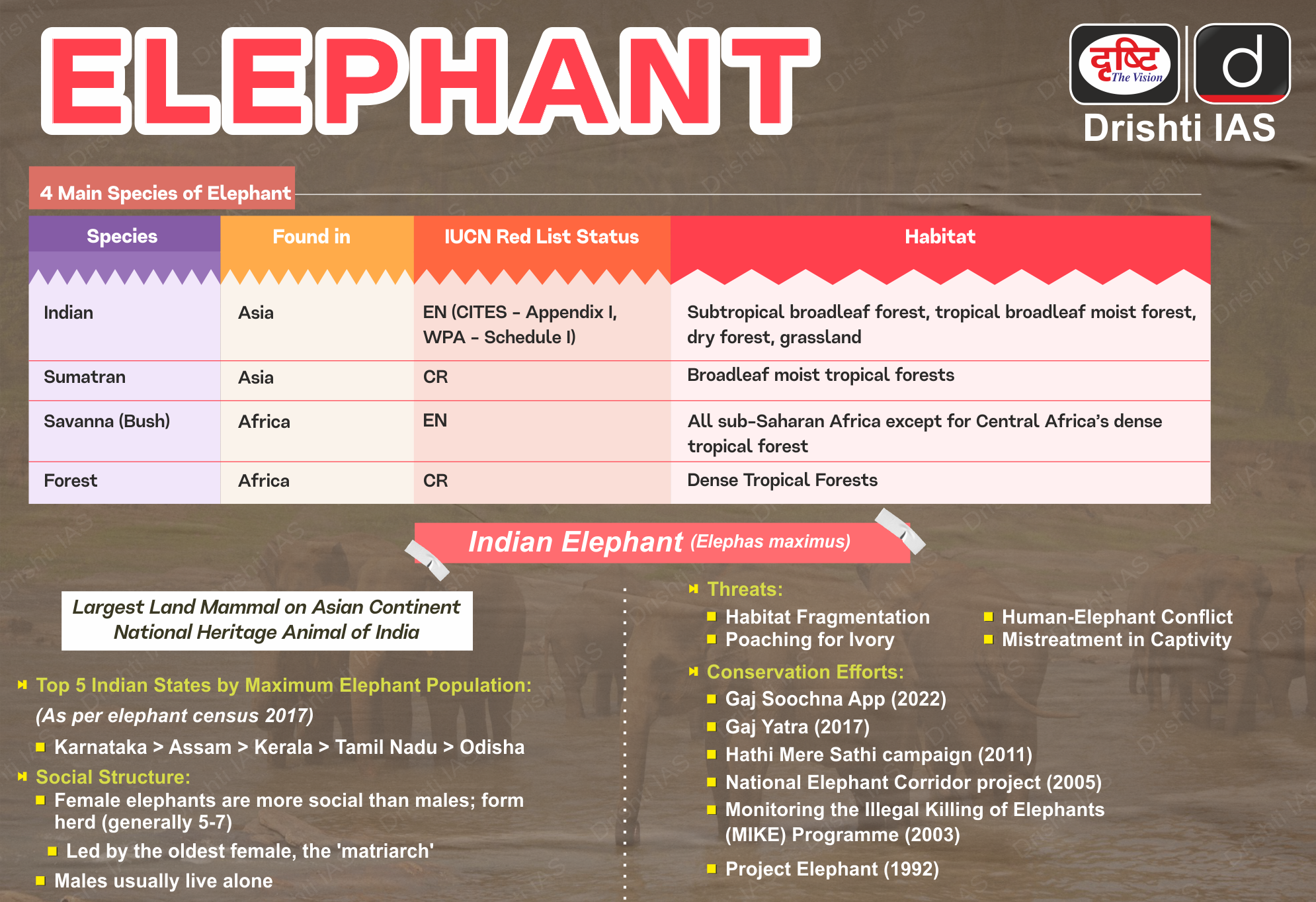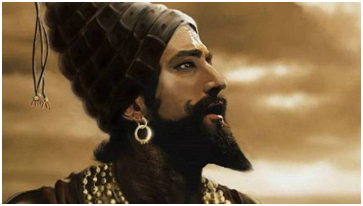Uttarakhand Switch to Hindi
Rajaji National Park
Why in News?
Abundant reservoirs and water holes built within Rajaji National Park have limited elephant movement into human-populated areas.
Key Points
- Reduced Elephant Dependence on the Ganga:
- Large herds of elephants no longer rely heavily on the Ganga River, even during the summer months.
- The increased availability of water sources within forest areas has made elephants more self-sufficient.
- Role of Amrit Sarovar Yojana:
- The Amrit Sarovar Yojana has significantly improved the water situation in the forests.
- The scheme aims to develop or rejuvenate 75 Amrit Sarovar ponds in each district across the country.
- It was launched in 2022, as part of India's "Azadi Ka Amrit Mahotsav" celebrations for the 75th year of independence.
- Impact on Human-Wildlife Conflict:
- The improved water availability within the forest has reduced elephant movement into human-populated areas.
- As a result, instances of human-elephant conflict have declined, enhancing safety for both wildlife and local communities.
Rajaji National Park
- About:
- Rajaji National Park is located in the state of Uttarakhand, India.
- It spans across three districts Dehradun, Haridwar and Pauri Garhwal.
- The park was established by merging three wildlife sanctuaries- Rajaji, Motichur and Chilla.
- It is named after C. Rajagopalachari, a prominent freedom fighter, fondly known as “Rajaji”.
- Area and Tiger Reserve Status:
- Initially, Rajaji National Park covered an area of 820.42 sq km.
- In 2015, an additional 255.63 sq km of adjoining reserve forest was designated as a buffer zone.
- The combined area of 1075 sq km was then declared as the Rajaji Tiger Reserve under the Wild Life (Protection) Act, 1972.
- Rivers in the Reserve:
- The Ganges River flows through the Rajaji Tiger Reserve, enhancing the region’s ecological richness.
- The Song River, a tributary of the Ganga, also traverses the reserve, supporting diverse wildlife and vegetation.
- Elephant Corridor and Connectivity:
- The reserve contains an important elephant corridor, which ensures safe movement of elephants between Rajaji and Corbett National Park, promoting genetic diversity and reducing human-elephant conflict
Maharashtra Switch to Hindi
Chhatrapati Shivaji Maharaj Circuit Tour
Why in News?
The Indian Railway Catering and Tourism Corporation (IRCTC) announced the launch of the first Chhatrapati Shivaji Maharaj Circuit Tour via the Bharat Gaurav tourist train starting 9 June 2025, to commemorate the 350th anniversary of the legendary Maratha ruler’s coronation.
Key Points
- Details of the Tour:
- The initiative is being jointly promoted by IRCTC, Maharashtra Tourism Development Corporation (MTDC), and the Government of Maharashtra.
- The Bharat Gaurav tourist train will begin its journey on June 9 from Chhatrapati Shivaji Maharaj Terminus (CSMT), Mumbai.
- It can accommodate a total of 748 passengers.
- Places Covered Under the Tour:
- Raigad Fort (Raigad District)
- Significance: On 6th June, 1674 CE a grand coronation ceremony of Shivaji Maharaj was held on Raigad post, during which he attained the title of “Chhatrapati”.
- The fort served as the second capital of Shivaji Maharaj and played an important role in the administration and expansion of the Maratha Kingdom.
- Shivneri Fort (Junnar, Pune District)
- Significance: Birthplace of Chhatrapati Shivaji Maharaj.
- Shivneri Fort has ancient origins, with references dating back to the Satavahana and Yadava dynasties.
- Over time, it changed hands from the Bahmani Empire to the Marathas under the leadership of Shivaji Maharaj.
- Bhimashankar (near Junnar, Pune District)
- Significance: It is one of the 12 holy Jyotirlinga shrines in India.
- Originally built in the 13th century, the temple reflects the craftsmanship of the Vishwakarma sculptors.
- Maratha statesman Nana Phadnavis added the shikharas in the 18th century, while Shivaji Maharaj is believed to have supported worship through his patronage.
- Pratapgad Fort (Satara District)
- Significance: The Battle of Pratapgarh, fought on November 10, 1659, at Pratapgad Fort was a pivotal victory for the Marathas, led by Chhatrapati Shivaji, over the Adilshahi forces commanded by General Afzal Khan.
- Panhala Fort (Kolhapur District)
- Significance: It served as a crucial Maratha stronghold and was also the residence of Shivaji Maharaj during significant periods of his reign.
- Raigad Fort (Raigad District)
Chhatrapati Shivaji Maharaj
- About:
- Born on 19th February 1630, at Shivneri Fort, Pune was a visionary leader from the Bhonsle clan and the founder of the Maratha Empire, known for resisting the Mughal Empire and striving for self-rule.
- Major Battles:
- Battle of Pratapgad, Battle of Pavan Khind, Sacking of Surat, Battle of Purandar, Battle of Sinhagad, and Battle of Sangamner.
- The Wagh nakh, was used by Shivaji to kill Afzal Khan in the 1659 Battle of Pratapgad.
- Titles:
- Chhatrapati, Shakakarta, Kshatriya Kulavantas, and Haindava Dharmodhhaarak.
- Administration:
- Centralized administration with the Ashtapradhan (Council of Eight Ministers), abolished the Jagirdari System, implemented the Ryotwari System, and built a strong naval force for coastal defense.
- Shivaji is renowned for his innovative guerrilla warfare tactics, which influenced subsequent rulers and shaped the Maratha Military Landscapes.
- Centralized administration with the Ashtapradhan (Council of Eight Ministers), abolished the Jagirdari System, implemented the Ryotwari System, and built a strong naval force for coastal defense.
Uttar Pradesh Switch to Hindi
Veer Rath Park
Why in News?
Veer Rath Park, along with a museum and open-air theatre, will be developed in Noida, Uttar Pradesh to honour the heroes of the freedom struggle.
Key Points
- About the park:
- This park is being established in Nalgarh village near Noida-Greater Noida Expressway with the aim of preserving and showcasing the legacy of 32 freedom fighters.
- Historically, Nalgarh village has been the refuge of Shaheed Bhagat Singh, Rajguru, Sukhdev, Subhash Chandra Bose and Colonel Karnail Singh of the Azad Hind Fauj.
- It is believed that these fighters stayed here and prepared strategies to attack the British army.
- This park will be established on approximately 22 acres of land, with an estimated cost of Rs 42 crore .
- The park will also have a museum that will house stone statues of freedom fighters along with informational exhibits.
- Stories of freedom fighters and army personnel will also be inscribed on the walls of the museum .
- Wartime tanks and fighter jets will symbolically showcase India’s military heritage, while a laser show will inspire patriotism. An open-air theatre will host cultural programmes themed on India’s independence.
- This park is being established in Nalgarh village near Noida-Greater Noida Expressway with the aim of preserving and showcasing the legacy of 32 freedom fighters.
Azad Hind Fauj (INA)
- Introduction: It was a military force formed with the aim of countering British rule in India during the Second World War and played an important role in India's freedom struggle.
- Formation:
- Mohan Singh: He proposed raising an army from Indian prisoners of war (POWs) and received Japanese support. He initially led the INA, recruiting about 40,000 soldiers.
- However, conflict with the Japanese over the number of troops led to their removal.
- Rashbehari Bose: He was an experienced revolutionary and played an important role in garnering support for the INA and formed the Indian Independence League in Tokyo (1942).
- Subhas Chandra Bose: On 25 August 1943, Bose was appointed Supreme Commander of the INA and later on 21 October 1943 , he established the Provisional Government of Free India or Azad Hind in Singapore.
- It was ratified by nine countries, including Japan, Germany, Italy , and China (led by Wang Jingwei).
- Mohan Singh: He proposed raising an army from Indian prisoners of war (POWs) and received Japanese support. He initially led the INA, recruiting about 40,000 soldiers.
Uttar Pradesh Switch to Hindi
Mission Shakti
Why in News?
The Uttar Pradesh government's Mission Shakti campaign has set a new benchmark in women empowerment by reaching over 9 crore women across the state.
Key Points
- About Mission Shakti Campaign :
- 'Mission Shakti' is an ambitious multi-dimensional scheme of the Uttar Pradesh Government aimed at ensuring safety, dignity and self-reliance of women and girls
- It was launched on 17 October 2020 and till now this campaign has been completed in five phases.
- Achievements and Statistics :
- 1,707 potential child marriages were prevented, ensuring the protection of the rights of girls.
- Women Helpline 1090 has successfully resolved 7.78 lakh cases so far .
- One Stop Centres provided relief in more than 2.10 lakh cases of violence and abuse .
- Through the Chief Minister Kanya Sumangala Yojana, benefits were provided to 23.40 lakh girls .
- More than 2 lakh girls were identified in the aspiring districts and were given assistance for their overall development.
- Investing in security infrastructure:
- 100 pink police booths have been set up in the state .
- The 1090 call centre has been expanded with 80 additional terminals .
- More than 1,100 pink toilets have been constructed in 189 urban bodies .
- Outreach has been done to villages, schools, colleges and urban wards through special events, training sessions and campaigns .
- Workshops have been organised on cyber crime, domestic violence, mental health, legal rights, financial literacy .
Chief Minister Kanya Sumangala Scheme
- Introduction:
- It was launched in April 2019 by the Women Welfare Department in Uttar Pradesh.
- Under the scheme, financial assistance of Rs. 15,000 is given to the family when a girl child is born in the family.
- This amount is given as an incentive in six phases, from the birth of the daughter till she graduates .
- Maximum two daughters from a family can get benefit of this scheme.
- Objective:
- The main objectives of the scheme are elimination of female foeticide , prevention of child marriage, increase in health and education and promotion of self-reliance .
Bihar Switch to Hindi
Contaminated Mid-Day Meal
Why in News?
The National Human Rights Commission (NHRC) took suo motu cognizance of over 100 students falling ill from contaminated Mid Day Meal in Patna and issued a notice to the Bihar government.
Key Points
- About Mid Day Meal Scheme:
- The Mid Day Meal Scheme (MDMS) is the largest school nutrition programme of its kind in the world, covering students enrolled in government schools from classes 1 to 8.
- The basic objective of this scheme is to increase enrollment in schools .
- Nodal Ministry: Ministry of Education
- Background: This programme was first started in 1925 in the Madras Municipal Corporation for underprivileged children.
- It was a Centrally Sponsored Scheme launched on a pilot basis in the year 1995 for children from Classes 1 to 5 and by October 2007 MDMS was extended to Class 8.
Madhya Pradesh Switch to Hindi
Biofuel Implementation Committee
Why in News?
Recently, the Madhya Pradesh government has constituted a high-powered committee to ensure effective implementation of biofuel projects.
Key Points
- About the of the Committee:
- This committee will be headed by the Chief Secretary.
- Members will include secretaries of the departments of Forest, Farmer Welfare and Agricultural Development, Urban Development and Housing, Animal Husbandry and Dairy, Food, Civil Supplies and Consumer Protection, Technical Education, Skill Development and Employment.
- The Secretary of the Department of New and Renewable Energy has been appointed as Member Secretary .
- Scope of work of the Committee :
- To consider cases for relaxation in land standards .
- To arrange for collection of Municipal Solid Waste (MSW) and ensure its easy availability to biofuel producers.
- To ensure availability of agricultural produce market waste and cow dung to biofuel producers.
- To encourage city gas distribution companies to use bio-CNG.
- To promote the use of Fermented Organic Manure among farmers.
- To arrange skills training in the biofuel sector.
Biofuels
- Any hydrocarbon fuel that is produced from organic matter (living or once-living material) in a short period of time (days, weeks or months) is called a biofuel.
- They can be used to fuel vehicles, heat homes, and generate electricity.
- Biofuels are considered renewable because they are made from plants that can be grown again and again.
- Biofuels can be solid, liquid or gaseous.
- Solid biofuels include wood, dry plant material, and manure.
- Liquid biofuels include bioethanol and biodiesel.
- Gaseous biofuels include biogas.
- Biofuels can replace or be used with fossil fuels for a variety of applications, such as generating heat and electricity.
- The transition to biofuels is driven by factors such as rising oil prices, greenhouse gas emissions from fossil fuels, and farmers' interest in obtaining fuel from their agricultural crops for profit

.gif)

.png)
















.png)


.jpg)



 PCS Parikshan
PCS Parikshan.jpg)



.jpg)
.jpg)
.jpg)

.jpg)


